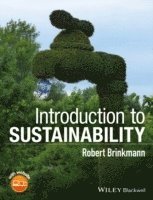
- Format
- Inbunden (Hardback)
- Språk
- Engelska
- Antal sidor
- 336
- Utgivningsdatum
- 2016-05-06
- Upplaga
- 1
- Förlag
- John Wiley & Sons Inc
- Dimensioner
- 249 x 193 x 23 mm
- Vikt
- Antal komponenter
- 1
- ISBN
- 9781118487143
- 908 g
Introduction to Sustainability
An Introduction
Kundrecensioner
Fler böcker av Robert Brinkmann
-
Practical Sustainability
Robert Brinkmann
-
Urban Sediment Removal
Robert Brinkmann, Graham A Tobin
-
Southeastern Geographer
Robert Brinkmann, Graham A Tobin
-
Carolina del Norte: Geographies of Latinization in the South
Robert Brinkmann, Graham A Tobin
Övrig information
Robert (Bob) Brinkmann is the Director of Sustainability Studies in the Department of Geology, Environment, and Sustainability at Hofstra University and is the author of many books and research articles. Bob has served as an officer in many organizations and is currently Chair of the Board of the National Cave and Karst Research Institute.
Innehållsförteckning
Acknowledgments, xv About the author, xvii About the companion website, xix 1 Roots of the modern sustainability movement 1 Meaning of sustainability 1 Nineteenth century environmentalism 2 Pinchot, Roosevelt, and Muir 4 Aldo Leopold and the land ethic 6 Better living through chemistry, the Great Smog of 1952, and Rachel Carson 6 Environmental activism of the 1960s and 1970s and the development of environmental policy 8 The growth of environmental laws in the 1960s and 1970s 10 The first Earth Day 11 International concerns 11 Ozone and the world comes together 12 Globalization and the Brundtland Report 12 Deep ecology 14 Environmental justice 15 Measuring sustainability 15 The road ahead 17 Organization 19 2 Understanding natural systems 21 The Earth, its layers, and the rock cycle 21 The rock cycle 23 Biogeochemical cycles 24 Water and the water cycle 24 The carbon cycle and global climate change 27 The sulfur cycle 29 The nitrogen and phosphorus cycles 31 Organisms and ecosystems 33 Urban ecosystems 35 Understanding the Anthropocene 38 3 Measuring sustainability 40 The United Nations Millennium Goals 40 Goal 1. Eradicate extreme poverty and hunger 41 Goal 2. Achieve universal primary education 42 Goal 3. Promote gender equality and empower women 42 Goal 4. Reduce child mortality rates 42 Goal 5. Improve maternal health 42 Goal 6. Combat HIV/AIDS, malaria, and other diseases 43 Goal 7: Ensure environmental sustainability 43 Goal 8: Develop a global partnership for development 43 National sustainability planning 45 Canada 45 Bhutan 48 Regional sustainability planning 49 Local sustainability measurement 51 Green local governments in Florida 53 Specific community plans 56 PlaNYC 56 London and sustainability 57 Small towns and sustainability 59 Business sustainability 60 Personal sustainability 61 4 Energy 63 World energy production and consumption 63 Traditional or dirty energy resources 65 Oil 65 Oil shale and tar sands 66 Natural gas 67 Coal 69 Green energy 71 Biomass 71 Wind energy 74 Solar energy 75 Nuclear energy 76 Other innovations 78 Energy efficiency 78 Living off the grid 80 5 Global climate change and greenhouse gas management 81 The end of nature? 81 The science of global climate change 81 The greenhouse effect 81 Sinks of carbon 86 Forests 86 Reefs 86 The IPCC and evidence for climate change, and the future of our planet 86 Ocean acidification 88 Phenological changes 88 Conducting greenhouse gas inventories 89 Step 1 Setting boundaries 89 Step 2 Defining scope 90 Step 3 Choosing a quantitative approach 91 Step 4 Setting a baseline year 91 Step 5 Engaging stakeholders 91 Step 6 Procuring certification 91 Greenhouse gas equivalents used in greenhouse gas accounting 92 Greenhouse gas emission scopes 92 De minimis emissions 92 Computing greenhouse gas credits 93 Climate action plans 93 Religion and climate change 98 Evangelical Environmental Network 98 Young Evangelicals for Climate Action 98 Catholic Climate Covenant 98 Jewish Climate Change Campaign 99 The International Muslim Conference on Climate Change 99 Buddhist Declaration on Climate Change 100 Hindu Declaration on Climate Change 100 Art, culture, and climate change 100 Swoon 100 Raul Cardenas Osuna and Toro Labs 101 Isaac Cordal 101 6 Water 103 Sources of water 103 Consumption trends 106 Sources of water pollution 108 Agricultural pollution 108 Industrial pollution 108 Storm water pollution 109 Sewage 109 Leaking underground tanks 109 Landfills 110 Water management and conservation 112 National and regional wate
Du kanske gillar
-
Peak Human
Johan Norberg
Häftad -
Peak Human
Johan Norberg
Inbunden
